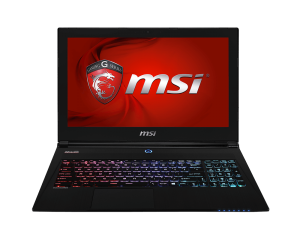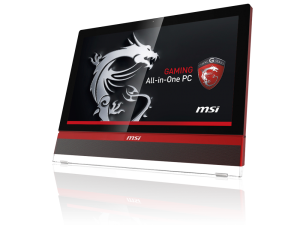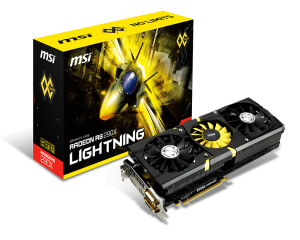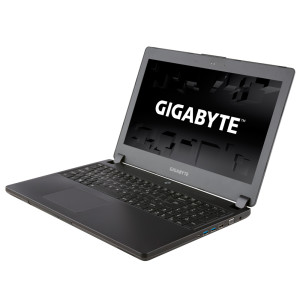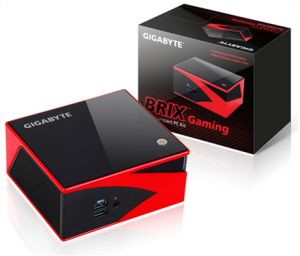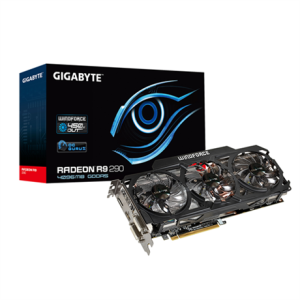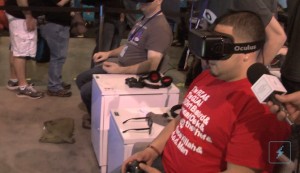MSI
As you would expect from a hardware vendor coming to a gaming convention, the focus for MSI was high end gaming, and boy did they come loaded for bear. Here are the top three products they had to show off.
MSI GS60 Ghost Pro
Gaming laptops have historically been large enough to be put in the category of desktop replacement, but with the latest wave of ultrabooks, we’ve seen a slimmer form factor with only a slight reduction in features. The GS60 Ghost Pro is no exception, featuring a 3K display, Intel i7-4700 HQ processor, GTX 860M graphics card sporting 2G of GDDR5 and a 128GB SSD with 750GB HDD. Its younger brother, the GS60 Ghost, has almost identical specs, but only features a 1080p screen (pshaw, right?). Coming in at less than an inch thick and under 5 pounds, this gaming monster is pretty much all you could ask for in a gaming ultrabook. It even has a fully programmable, rainbow backlit keyboard. Which is just so baller. The only downside is that when I was playing around with it, the fan was painfully hot. Maybe that wouldn’t be an issue normally, but after 4 hours of playing Bioshock Infinite, it was not advisable to touch that fan.
AG2712A
Even a few years ago, PC proponents would talk about how terrible the all-in-one paradigm that Apple had stuck to was a terrible idea, but now we see tons of PC all-in-one popping up from every manufacturer. MSI has taken this idea and run with it, creating an all-in-one aimed at gamers that’s sure to chew through anything you throw at it.
The AG2712A features a 27” touch screen with Windows 8 (come on, it just doesn’t make sense without a touch screen) and an Intel i7-3630QM processor. The 16 GB of DDR3 RAM and 128GB SSD are sure handle any modern game, and the 2TB HDD is ready to hold your collection of anime and completely legitimately downloaded movies. Perhaps the most interesting feature of this all in one is its HDMI in port, allowing the computer to be used as an external monitor or TV. So if you’re looking for a gaming PC and a TV at the same time, you’ve got one right here. “But I want to mount it,” you say? Well you can! VESA mounts are built in, though the ports are in such a position that you’d probably want an extendable arm to fit all the cables behind it. The screen also features flicker-free technology, anti -glare matting, and a whole bunch of other cool stuff. Coming in at around $1800 bucks, this unique form factor PC is optimal for low desk space or multipurpose use.
R9 290X Lightning
What? Just look at this thing and join me in asking “what?”
The R9 290X Lightning is the biggest graphics card I’ve ever seen. Not only was it longer than all of the motherboards MSI showed off, but it took up more than two slots! With that kind of size, it has to have wildly awesome specs.
And it does! 1.08 GHz core with 4GB of GDDR5 at 5GHz memory puts this thing toward the top of its class. This monster is kept cool with three fans, all of which you can monitor and control through software. It outputs to 2 Dual-link DVI-D ports, one display port and an HDMI port and has a maximum supported resolution of 2560×1600. It also supports DirectX 11.2 and OpenGL 4.3 and has support for Crossfire, which just seems unnecessary. If you can fit two of these in a case and decide to do this, you must be a mad scientist.
I’m told there’s also a shortage of product, not only due to ravenous gamers, but also Bitcoin miners looking to upgrade their rigs. If it comes back in stock and you have three slots to spare in your box, you can’t get much better than the R9 290X Lightning.
And if you’re interested in the full interviews, you can listen to them here:
Gigabyte
Not to be topped by MSI, Gigabyte also had some great products to show off this year.
P35W v2
Coming in at 20.9mm, the P35W v2 has a crazy thin design for all its monstrous components. It sports a GTX 870M with 6GB of GDDR5 Ram and an Intel i7-4710HQ processor. Combine that with 8-16GB of DDR3 RAM, RAID support with 2 SSDs and one HDD, and a 1920×1080 resolution and this laptop is a beast. And for those of you still stuck on physical media, it also has a Blu-ray RW drive. One of the best things about this model is that it’s configurable, configurable, allowing the user to choose from a few different processors, RAM, storage, and graphics offerings.
If you’re looking for a thin, light gaming laptop with some configurability, Gigabyte has a great solution in the P35W v2.
Brix Gaming
PC manufacturers have been trying to do smaller and smaller enclosures for machines for some time now, but it only really picked up when HTPCs became a big deal. As a result, it’s taken a while before something small, but gamer-oriented was released, but now it’s here. Meet the Brix Gaming.
Gigabyte’s Brix line has been one of the best small form factor PCs for a while, but it’s difficult to fit all you need in a gaming PC into a box that tiny. Gigabyte’s finally figured it out, though. The Brix Gaming features an AMD A8-5557M processor and a Radeon R9 M275X GPU featuring 2GB of DDR5 RAM. 2 DDR3 slots mean up to 16GB or RAM (you can configure this), and it supports 2.5”thickness hard drives with a 6Gbps SATA3 port. Throw in 4 USb3.0 slots, an HDMI port, mini DisplayPort, RJ45, and VESA mount support and the Brix Gaming is pretty desirable. For all of this, you’d think it’d be huge, but it only stands at 59.6mm thick, and 128×115.4mm around, small enough to throw in a backpack and take to the LAN party down the block. Now if only they made foldable monitors…
R929OC-4GD
Featuring AMD’s latest R9 design, the R9 290, the R929OC-4GD features 4GB of GDDR5 RAM and a 1.04 GHz core clock. It outputs to an HDMI port, a Display Port and two DVI ports. It also supports a max resolution of 4096×2160, so everyone trying to get a leg up on the new 4k wave, this card has you covered with the HDMI or DP ports.
The R929OC-4GD also supports DirectX 11.2 and OpenGL 4.3. Somehow, Gigabyte also managed to cram all of this into a 2 slot design, making it easy to Crossfire this bad boy.
If you’re looking for the latest AMD has to offer, Gigabyte has a card with all the right specs.
You can hear our full discussion here:
Oculus
I wasn’t sure if I should include this in gaming or hardware, but since I got to play with an Oculus last, it’s improved its hardware so much that I felt it was best to talk about its components.
The fine people at Oculus sat me down and let me play Couch Knights, a small demo game in which you control little warriors fighting each other in a living room. It looks something like this:
I think the best part of the demo was being told to look around to get my bearings. Left was fine, right was fine, up was fine, down was temporarily terrifying. I this demo, you’re a static body sitting down, so when I looked down, I saw limbs that were not my own positioned very similarly to my own body. And my brain couldn’t handle it. For about a second, I had a feeling like “OH MY GOD I CAN’T MOVE MY BODY WHOSE LIMBS ARE THOoh wait, right, VR.” So cool.
The Oculus Rift will be hitting retail shelves this year and if my hunch is right, will have better hardware than even this design does currently. Get hyped!
The overwhelmingly negative response to Facebook’s acquisition of Oculus really surprised me, so here are some reasons why I think this could be a great thing not only for Oculus, but for VR and the gaming industry as a whole.


